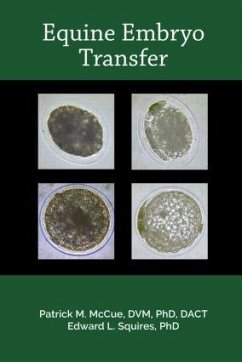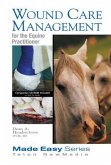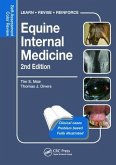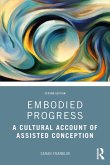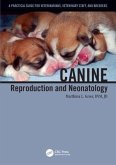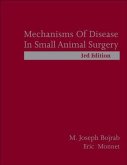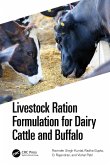Patrick M. McCue (USA Colorado State University), Edward L. Squires (Gluck Equine Research Center, Lexington, Kentuck
Equine Embryo Transfer
Patrick M. McCue (USA Colorado State University), Edward L. Squires (Gluck Equine Research Center, Lexington, Kentuck
Equine Embryo Transfer
- Broschiertes Buch
- Merkliste
- Auf die Merkliste
- Bewerten Bewerten
- Teilen
- Produkt teilen
- Produkterinnerung
- Produkterinnerung
This book briefly reviews the history of equine embryo transfer, covering in clinically practical terms the techniques, equipment, and management protocols currently in use.
Andere Kunden interessierten sich auch für
![Wound Care Management for the Equine Practitioner Wound Care Management for the Equine Practitioner]() Dean A. Hendrickson (University of College of Veterinary MedicineWound Care Management for the Equine Practitioner75,99 €
Dean A. Hendrickson (University of College of Veterinary MedicineWound Care Management for the Equine Practitioner75,99 €![Equine Internal Medicine Equine Internal Medicine]() Tim S. Mair (UK Bell Equine Veterinary Clinic)Equine Internal Medicine61,99 €
Tim S. Mair (UK Bell Equine Veterinary Clinic)Equine Internal Medicine61,99 €![Embodied Progress Embodied Progress]() Sarah FranklinEmbodied Progress41,99 €
Sarah FranklinEmbodied Progress41,99 €![Canine Reproduction and Neonatology Canine Reproduction and Neonatology]() Marthina L. Greer (International Canine Semen Bank, Wisconsin, USA)Canine Reproduction and Neonatology102,99 €
Marthina L. Greer (International Canine Semen Bank, Wisconsin, USA)Canine Reproduction and Neonatology102,99 €![Mechanisms of Disease in Small Animal Surgery Mechanisms of Disease in Small Animal Surgery]() M. Joseph Bojrab (University of Geo College of Veterinary MedicineMechanisms of Disease in Small Animal Surgery180,99 €
M. Joseph Bojrab (University of Geo College of Veterinary MedicineMechanisms of Disease in Small Animal Surgery180,99 €![Neosporosis in Animals Neosporosis in Animals]() J. P. DubeyNeosporosis in Animals263,99 €
J. P. DubeyNeosporosis in Animals263,99 €![Livestock Ration Formulation for Dairy Cattle and Buffalo Livestock Ration Formulation for Dairy Cattle and Buffalo]() Ravinder Singh KuntalLivestock Ration Formulation for Dairy Cattle and Buffalo111,99 €
Ravinder Singh KuntalLivestock Ration Formulation for Dairy Cattle and Buffalo111,99 €-
-
-
This book briefly reviews the history of equine embryo transfer, covering in clinically practical terms the techniques, equipment, and management protocols currently in use.
Hinweis: Dieser Artikel kann nur an eine deutsche Lieferadresse ausgeliefert werden.
Hinweis: Dieser Artikel kann nur an eine deutsche Lieferadresse ausgeliefert werden.
Produktdetails
- Produktdetails
- Verlag: Teton NewMedia
- Seitenzahl: 184
- Erscheinungstermin: 18. Februar 2015
- Englisch
- Abmessung: 228mm x 149mm x 12mm
- Gewicht: 304g
- ISBN-13: 9781591610472
- ISBN-10: 1591610478
- Artikelnr.: 40052046
- Herstellerkennzeichnung
- Libri GmbH
- Europaallee 1
- 36244 Bad Hersfeld
- gpsr@libri.de
- Verlag: Teton NewMedia
- Seitenzahl: 184
- Erscheinungstermin: 18. Februar 2015
- Englisch
- Abmessung: 228mm x 149mm x 12mm
- Gewicht: 304g
- ISBN-13: 9781591610472
- ISBN-10: 1591610478
- Artikelnr.: 40052046
- Herstellerkennzeichnung
- Libri GmbH
- Europaallee 1
- 36244 Bad Hersfeld
- gpsr@libri.de
Patrick M. McCue, Edward L. Squires
Contents 1. Introduction General Introduction (i.e. what is ET) Advantages
and uses of embryo transfer Changes in the ET Industry Breed regulations
(include a Table of most major breeds; ET, frozen embryos, etc.) Per cycle
ET Success = Embryo Collection Rate (50-60%) x Embryo Transfer Pregnancy
Rate (70-80%)Goals of the Manual 2. History of equine embryo transfer
Livestock Horses Domestic horses as surrogates for endangered equids(?) 3.
Reproductive Anatomy and Physiology of the MareAnatomy of the mare
Physiology of the estrous cycle Physiology of early embryonic development
and early pregnancy 4. Management of the donor mare Selection of the donor
Evaluation of the donor (BSE)Management and Day of breeding (fresh, cooled,
frozen semen) Palpation/ultrasound examinations relative to flush; daily vs
every 6-8 hrs for frozen semen; BID if goal is to collect a small embryo at
day 6.5 for cryopreservation Induction of ovulation (hCG and deslorelin)
Donor mare management (PMIE, fluid, etc.)Estrous cycle control (Lights,
P&E, PGF, hCG, Deslorelin, Regumate) Allow a mare to carry to term by
approximately 10 years of age Allowing mare to carry own every 3-4 years
Effect of repeated flushing on uterine health and embryo recovery # flushes
per year recommendedFertility of mares after flushing (i.e. same
season)Problem mares (i.e. PMIE, etc.) Maiden mares (young vs older)Post
partum mares (i.e. flushing on foal heat) 5.
SuperovulationHistoryTechniques EFSH Optimal follicle size at onset
Problems - same stallion vs. goal of different stallions Not every mare
responds to FSHPAF's and HAF's 6. Embryo Collection Equipment (Box Table)
Facilities (stocks vs stall, etc.) Procedure; (incl. clean out and wash up)
Ultrasound prior to flush in problem
and uses of embryo transfer Changes in the ET Industry Breed regulations
(include a Table of most major breeds; ET, frozen embryos, etc.) Per cycle
ET Success = Embryo Collection Rate (50-60%) x Embryo Transfer Pregnancy
Rate (70-80%)Goals of the Manual 2. History of equine embryo transfer
Livestock Horses Domestic horses as surrogates for endangered equids(?) 3.
Reproductive Anatomy and Physiology of the MareAnatomy of the mare
Physiology of the estrous cycle Physiology of early embryonic development
and early pregnancy 4. Management of the donor mare Selection of the donor
Evaluation of the donor (BSE)Management and Day of breeding (fresh, cooled,
frozen semen) Palpation/ultrasound examinations relative to flush; daily vs
every 6-8 hrs for frozen semen; BID if goal is to collect a small embryo at
day 6.5 for cryopreservation Induction of ovulation (hCG and deslorelin)
Donor mare management (PMIE, fluid, etc.)Estrous cycle control (Lights,
P&E, PGF, hCG, Deslorelin, Regumate) Allow a mare to carry to term by
approximately 10 years of age Allowing mare to carry own every 3-4 years
Effect of repeated flushing on uterine health and embryo recovery # flushes
per year recommendedFertility of mares after flushing (i.e. same
season)Problem mares (i.e. PMIE, etc.) Maiden mares (young vs older)Post
partum mares (i.e. flushing on foal heat) 5.
SuperovulationHistoryTechniques EFSH Optimal follicle size at onset
Problems - same stallion vs. goal of different stallions Not every mare
responds to FSHPAF's and HAF's 6. Embryo Collection Equipment (Box Table)
Facilities (stocks vs stall, etc.) Procedure; (incl. clean out and wash up)
Ultrasound prior to flush in problem
Contents 1. Introduction General Introduction (i.e. what is ET) Advantages
and uses of embryo transfer Changes in the ET Industry Breed regulations
(include a Table of most major breeds; ET, frozen embryos, etc.) Per cycle
ET Success = Embryo Collection Rate (50-60%) x Embryo Transfer Pregnancy
Rate (70-80%)Goals of the Manual 2. History of equine embryo transfer
Livestock Horses Domestic horses as surrogates for endangered equids(?) 3.
Reproductive Anatomy and Physiology of the MareAnatomy of the mare
Physiology of the estrous cycle Physiology of early embryonic development
and early pregnancy 4. Management of the donor mare Selection of the donor
Evaluation of the donor (BSE)Management and Day of breeding (fresh, cooled,
frozen semen) Palpation/ultrasound examinations relative to flush; daily vs
every 6-8 hrs for frozen semen; BID if goal is to collect a small embryo at
day 6.5 for cryopreservation Induction of ovulation (hCG and deslorelin)
Donor mare management (PMIE, fluid, etc.)Estrous cycle control (Lights,
P&E, PGF, hCG, Deslorelin, Regumate) Allow a mare to carry to term by
approximately 10 years of age Allowing mare to carry own every 3-4 years
Effect of repeated flushing on uterine health and embryo recovery # flushes
per year recommendedFertility of mares after flushing (i.e. same
season)Problem mares (i.e. PMIE, etc.) Maiden mares (young vs older)Post
partum mares (i.e. flushing on foal heat) 5.
SuperovulationHistoryTechniques EFSH Optimal follicle size at onset
Problems - same stallion vs. goal of different stallions Not every mare
responds to FSHPAF's and HAF's 6. Embryo Collection Equipment (Box Table)
Facilities (stocks vs stall, etc.) Procedure; (incl. clean out and wash up)
Ultrasound prior to flush in problem
and uses of embryo transfer Changes in the ET Industry Breed regulations
(include a Table of most major breeds; ET, frozen embryos, etc.) Per cycle
ET Success = Embryo Collection Rate (50-60%) x Embryo Transfer Pregnancy
Rate (70-80%)Goals of the Manual 2. History of equine embryo transfer
Livestock Horses Domestic horses as surrogates for endangered equids(?) 3.
Reproductive Anatomy and Physiology of the MareAnatomy of the mare
Physiology of the estrous cycle Physiology of early embryonic development
and early pregnancy 4. Management of the donor mare Selection of the donor
Evaluation of the donor (BSE)Management and Day of breeding (fresh, cooled,
frozen semen) Palpation/ultrasound examinations relative to flush; daily vs
every 6-8 hrs for frozen semen; BID if goal is to collect a small embryo at
day 6.5 for cryopreservation Induction of ovulation (hCG and deslorelin)
Donor mare management (PMIE, fluid, etc.)Estrous cycle control (Lights,
P&E, PGF, hCG, Deslorelin, Regumate) Allow a mare to carry to term by
approximately 10 years of age Allowing mare to carry own every 3-4 years
Effect of repeated flushing on uterine health and embryo recovery # flushes
per year recommendedFertility of mares after flushing (i.e. same
season)Problem mares (i.e. PMIE, etc.) Maiden mares (young vs older)Post
partum mares (i.e. flushing on foal heat) 5.
SuperovulationHistoryTechniques EFSH Optimal follicle size at onset
Problems - same stallion vs. goal of different stallions Not every mare
responds to FSHPAF's and HAF's 6. Embryo Collection Equipment (Box Table)
Facilities (stocks vs stall, etc.) Procedure; (incl. clean out and wash up)
Ultrasound prior to flush in problem

